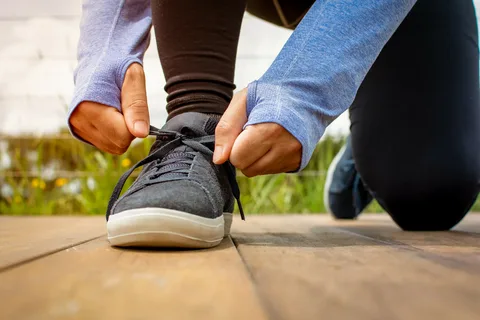Have you ever wondered what goes into creating a shoe that is both comfortable and healthy for your feet? It’s a process that involves a lot of expertise, attention to detail, and care. In this blog post, we’ll take a behind-the-scenes look at how Podiatry Approved Shoes specifically designed for optimal foot health. From the materials used to the intricate construction techniques, you’ll discover the secrets to creating shoes that can help improve your foot health.
The Importance of Podiatry-Approved Shoes
When it comes to foot health, wearing the right shoes is crucial. That’s where podiatry-approved shoes come in. These specialized shoes are specifically designed to promote optimal foot health and comfort. But why are they so important?
Firstly, podiatry-approved shoes are crafted with a deep understanding of foot anatomy and biomechanics. Podiatrists, who are experts in foot health, are involved in every step of the design process. This ensures that the shoes provide the right support and stability for your feet, helping to prevent common foot problems such as plantar fasciitis, bunions, and heel pain. Secondly, podiatry-approved shoes are made with high-quality materials that prioritize breathability and flexibility. This allows your feet to stay cool and comfortable throughout the day, reducing the risk of foot odor and infections.
Finally, podiatry-approved shoes are built to last. The meticulous construction techniques used in their production ensure durability and longevity. By investing in a pair of podiatry-approved shoes, you can enjoy the benefits of healthy and comfortable feet for years to come.
Materials Used in Making Podiatry-Approved Shoes
When it comes to creating podiatry-approved shoes, the materials used are of utmost importance. These shoes are crafted with a deep understanding of foot health, and every component is carefully chosen to prioritize comfort, support, and durability.
One crucial material used in podiatry-approved shoes is high-quality leather. Leather is not only durable but also provides excellent breathability and flexibility. This allows for proper airflow, preventing excessive sweating and reducing the risk of foot odor and infections.
Additionally, podiatry-approved shoes often feature cushioned midsoles made from materials like EVA (ethylene-vinyl acetate) or memory foam. These materials provide shock absorption and excellent cushioning, ensuring that your feet stay comfortable throughout the day.
The outsoles of these shoes are typically made from durable rubber or rubber compounds. This ensures excellent traction and grip, reducing the risk of slips and falls. Furthermore, podiatry-approved shoes may incorporate innovative materials like mesh or knit uppers. These materials enhance breathability, adaptability, and flexibility, providing a snug and comfortable fit.
Design and Construction Techniques for Optimal Foot Health
When it comes to designing and constructing shoes for optimal foot health, podiatrists employ a range of techniques to ensure maximum comfort and support. One key aspect is the inclusion of features that promote proper alignment and stability. This can include specialized insoles that provide arch support and cushioning, as well as ergonomic designs that encourage natural foot movement.
 Another important consideration is the construction of the shoe itself. Podiatrists often prioritize lightweight and flexible materials that allow for unrestricted foot movement. They may also incorporate features such as reinforced toe caps and heel counters to provide added protection and stability.
Another important consideration is the construction of the shoe itself. Podiatrists often prioritize lightweight and flexible materials that allow for unrestricted foot movement. They may also incorporate features such as reinforced toe caps and heel counters to provide added protection and stability.
Furthermore, podiatrists pay close attention to the shape and fit of the shoe. They understand that different individuals have different foot shapes and sizes, and they strive to create designs that accommodate these variations. This can involve using multiple width options or adjustable straps to ensure a customized and comfortable fit.
The Role of Podiatrists in Creating Podiatry-Approved Shoes
Podiatrists play a crucial role in the creation of podiatry-approved shoes. As experts in foot health, they bring their deep understanding of foot anatomy and biomechanics to the design process. Podiatrists work closely with shoe manufacturers to ensure that every aspect of the shoe promotes optimal foot health and comfort.
One of the main contributions of podiatrists is their expertise in providing support and stability. They understand the common foot problems that people face, such as plantar fasciitis and bunions, and incorporate features into the shoes that help prevent these issues. From arch support to cushioning insoles, podiatrists ensure that the shoes provide the right level of support for different foot types.
Additionally, podiatrists contribute to the choice of materials used in the shoes. They prioritize materials that are breathable, flexible, and durable, ensuring that the shoes provide comfort throughout the day. Podiatrists also pay attention to the shape and fit of the shoe, understanding that not all feet are the same. By creating designs that accommodate different foot shapes and sizes, they ensure that the shoes fit properly and provide maximum comfort.
Maximizing Comfort and Support through Insole Technology
When it comes to creating shoes that maximize comfort and support, insole technology plays a crucial role. Podiatrists understand that the right insole can make all the difference in promoting optimal foot health and reducing discomfort. That’s why they put a great deal of thought and expertise into designing insoles that provide the perfect balance of cushioning, support, and stability.
One key aspect of insole technology is the use of materials that offer excellent shock absorption. This helps to reduce the impact on your feet and joints, preventing discomfort and potential injuries. Podiatrists often incorporate materials like memory foam or EVA (ethylene-vinyl acetate) in the insoles to provide cushioning and distribute pressure evenly.
Another important consideration is arch support. Podiatrists design insoles with different levels of arch support to accommodate various foot types. Whether you have high arches or flat feet, the right insole can help align your feet properly and alleviate stress on your arches. Additionally, podiatrists prioritize stability when designing insoles. By incorporating features like heel cups or extra padding in the heel area, they enhance stability and reduce the risk of excessive pronation or supination.
Exploring Innovations in Podiatry Approved Shoes
As technology and innovation continue to advance, the world of Podiatry Approved Shoes is not far behind. There are constant innovations and exciting developments that aim to further enhance foot health and comfort. Let’s explore some of these innovations in podiatry-approved footwear.
One area of innovation is the use of 3D printing technology. This cutting-edge technology allows for the creation of customized shoes that perfectly match the shape and size of an individual’s foot. With 3D printing, podiatrists can create shoes that provide unparalleled comfort and support, as they are tailored to each person’s unique foot anatomy.
Another exciting innovation is the incorporation of smart technology into shoes. These smart shoes often come with sensors that can track various aspects of foot health, such as pressure distribution and gait analysis. This data can be analyzed by podiatrists to gain valuable insights into an individual’s foot health and make necessary adjustments to the shoe design for optimal support and comfort.
Furthermore, there are advancements in materials used in podiatry-approved footwear. For example, there are shoes made from sustainable and eco-friendly materials, catering to individuals who are conscious of the environmental impact of their choices. These materials are not only better for the planet but also provide excellent breathability and durability, ensuring long-lasting comfort for the wearer.
Eco-Friendly Practices in Podiatry-Approved Footwear Production
When it comes to creating podiatry-approved footwear, the focus isn’t just on foot health and comfort. It’s also about being mindful of our impact on the environment. That’s why many podiatrists and shoe manufacturers are embracing eco-friendly practices in the production of these shoes. One of the key eco-friendly practices is the use of sustainable and renewable materials. Instead of relying solely on traditional materials, such as leather, podiatry-approved footwear now incorporates innovative materials made from recycled plastics, organic cotton, and natural fibers. These materials not only reduce waste but also minimize the carbon footprint of the manufacturing process.
Additionally, shoe manufacturers are adopting more sustainable manufacturing processes. They are using water-based adhesives and dyes, which are less harmful to the environment. Some manufacturers are even investing in renewable energy sources, such as solar power, to power their production facilities.
Furthermore, the packaging of podiatry-approved footwear is also being rethought. Many manufacturers are transitioning to eco-friendly packaging materials, such as recycled cardboard and biodegradable plastics.
FAQs
You might have some burning questions about podiatry-approved shoes, and we’re here to answer them! Check out these frequently asked questions to learn more about these specialized shoes and how they can benefit your foot health:
1. Are podiatry-approved shoes only for people with foot problems?
No, podiatry-approved shoes are designed to promote optimal foot health for everyone. Whether you have specific foot concerns or simply want to prioritize your foot health, these shoes can benefit anyone.
2. Can podiatry-approved shoes be stylish?
Absolutely! Podiatry-approved shoes are available in a wide range of styles and designs. You don’t have to sacrifice fashion for foot health.
3. How often should I replace my podiatry-approved shoes?
It depends on several factors, including the frequency of use and the wear and tear on the shoes. As a general rule, it’s recommended to replace your shoes every 6-12 months or when you notice signs of wear and discomfort.
Conclusion
In conclusion, creating podiatry-approved shoes is a meticulous process that involves a deep understanding of foot anatomy and biomechanics. Podiatrists play a vital role in designing shoes that prioritize foot health and comfort. From the choice of materials to the construction techniques and innovative technologies, every aspect is carefully considered to provide the best possible support for your feet.
| Other Good Articles to Read |
| Blogs-Nation |
| Blogs-Peoples |
| Bryan Smith Blogs |
| intellect blogs |
| the fault in our blogs |
| blogs eu |
| oz forums |
| Recruitment Blogs |
| Zet Blogs |
| Id Blogs |
| Blogs Tudiolegale |
| Blogs Map |



